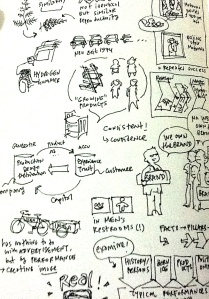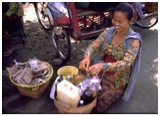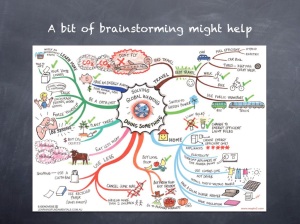MAGNO workshop, October 16, 2011

positive prejudice
In such a short notice, Singgih managed to invite his friends and colleagues to Temanggung for a one-day workshop with Oliver Errichiello, who distributes Magno products in Europe. About 30 people, a mix of students, designers, academics, entrepreneurs, etc. from Bandung, Yogyakarta, Solo and Jakarta, gathered in Kandangan Village, Temanggung, that day. For Oliver, who has been working with Singgih for five years, it was his first time to visit Indonesia and Magno production site. The workshop started at about 9AM and was divided into two sessions, the first one was a presentation about “BrandSociology” by Oliver, who is also a sociologist and a lecturer at a university in Hamburg, Germany, the second one was when he presented about Magno in Europe. The two sessions were split by a break, where all participants visited the old (first) Magno production site: a rented neighbor’s house, which is within a walking distance from the current site, before having lunch back at Magno. The sessions were closed with presentations from the audience about their products, which gained comments from Oliver, Singgih, and Katrin Greiling, a designer from Sweden who currently resides in Bandung and went to Temanggung with us.
Following are some pointers taken during the day.
=====
Singgih started his introduction by showing a photo of Oliver and his family. “Business is not about transaction. It’s about interaction”, he said, explaining that it is more comfortable to exchange ‘business’ emails with a personal touch.
=====

Oliver and audience (photo by: S.Riyadi)
Brandsociology: how to develop & manage brands. There’s no rational or marketing reason for people to choose the range of prices of something they’d buy.
Currently, people are faced with endless choices in the market. They will have to choose which items to purchase, and they will choose the ones that have a positive prejudice. It takes years to create the prejudice.
Brand = advertisements + logo? Not so. Brand has to do with image.
There should be a repeated pattern – not identical, but similar reproduction.
A brand that consistently repeats success gains confidence and a sympathetic image.

performing, not just stating, your brand
Companies often said that they own the brand. Wrong. Actually customers, people, are the ones owning the brand, since it is formed in their minds.
An example is IKEA, the first shop that puts up the “baby” sign on men’s restroom, indicating gender equality when it comes to caring for a baby. They also provide bikes with a cart attached to each, to enable people, who shop at IKEA but drive no car, to bring their purchased items home.
These services have nothing to do with advertisement, but they create image for IKEA by performance.
Communication is important. Brand shouldn’t merely say what they are, but they should perform accordingly.
Combining things that are not usually combined is also a strategy to make a brand stand out.
=====
Q&A with Oliver:

certifications?
How did you raise the need for Magno? By relaying the true story about its production, and by not introducing it as a mass-product, but creating a connection between the producer and the end-users.
Did you do a marketing study before selling Magno to Europe? For the first generation of Magno, I did it by feelings. No prior market studies or anything, I’m not so comfortable in “targeting consumers”. Take Apple, there’s no market research prior to product creation.
How would you develop further products (from Indonesia) that can achieve the same success as Magno? Give a stage to one designer in an international trade fair or exhibition, who has a product ‘champion’. It would be much better compared to what has been happening: Indonesia is often represented in such events by the government but not in a good way. Often than not, the person standing at the booth know nothing about the products, and nothing is explained by the display, so the products get drowned among other products at the events.
=====
Magno in Germany. It started in 2006 when we had nothing but passion.

no prior market research
Today, we are specializing in fine EcoDesign products for European market only, based in Hamburg, distributes to 250 shops all over Europe, and frequent participants of renown international fairs, all based on trust.
People should LIKE the products first, then they could feel like they DO GOOD due to the background of the products. Not the other way around.
EcoDesign = creating another kind of “business relation” between producer, distributor, reseller and consumer.
Eco-Credibility and “Green” standard: certifications can be a problem for such small producers. Don’t worry about certification as long as you’re honest.
Learn to say NO. When asked about the price of Magno, the answer is that it’s not a product, but it’s a project. A product without a story will end up merely in (production) price considerations.
=====
Singgih:

I know only a few steps. I go.
It’s the smile. The first impression of people looking at Magno is a smile. That, for me, means that my design is a success.
We sometimes lose contacts with things we do.
Magno’s copyright has never been registered. Aren’t you worried about copycats? I’m not focusing on copycats, but on creating products that educate people.
People can copy the design but not the story behind.
Besides, it’s not easy to copy my products: the small Magno wooden radio series contain more than 100 steps to produce, and the table clock takes more than 70 steps.
The principles of Magno products are: long lasting, special, and simple. They don’t follow trends.
Indonesia is a country full of “but”s. People who want to start something commonly say, “Yes it’s possible, BUT…” – continued with difficulties they’re facing. Don’t take the easy way!
I know my dream, but I didn’t know how to get there. All I know is only a few steps. I GO.
=====
Magno site: magno-design.com













































